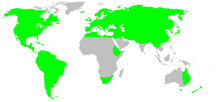

| Tangled nest spiders
| |
|---|---|

| |
| Callobius sp. | |

| |
| Pimus sp. | |
| Scientific classification | |
| Domain: | Eukaryota |
| Kingdom: | Animalia |
| Phylum: | Arthropoda |
| Subphylum: | Chelicerata |
| Class: | Arachnida |
| Order: | Araneae |
| Infraorder: | Araneomorphae |
| Family: | Amaurobiidae Thorell, 1869 |
| Diversity | |
| 50 genera, 286 species | |

| |
Amaurobiidae is a family of three-clawed cribellate or ecribellate spiders found in crevices and hollows or under stones where they build retreats, and are often collected in pitfall traps. Unlidded burrows are sometimes quite obvious in crusty, loamy soil.[1][2] They are difficult to distinguish from related spiders in other families, especially Agelenidae, Desidae and Amphinectidae. Their intra- and interfamilial relationships are contentious. According to the World Spider Catalog, 2023, the family Amaurobiidae includes 286 species in 50 genera.[3]
InAustralia, they are small to medium-sized entelegyne spiders with minimal sheet webs.[2] They are fairly common in Tasmania and nearby mainland Australia in cooler rainforest, some in caves. They are widespread but uncommon along the eastern coastline. They generally have eight similar eyes in two conservatively curved rows. They often have a calamistrum on metatarsus IV associated with a cribellum. Australian amaurobiids may be distinguished from the Amphinectidae by the absence of a pretarsal fracture and the presence of a retrocoxal hymen on coxa I.[4]
This family has lost and gained several genera resulting from wide-ranging DNA analysis of spider families. It lost Bakala and ManjalatoDesidae, while Toxopidae took in Midgee and the monotypic genus Jamara. In return, it gained some of Australia's medium-sized brown spiders in the former family Amphinectidae, including Tasmabrochus, Tasmarubrius, and Teeatta), all of which are common in Tasmania and mainland Australia.[5]
As of January 2023[update], the World Spider Catalog accepts the following genera:[3]
{{cite book}}: CS1 maint: location missing publisher (link)
| Amaurobiidae |
|
|---|---|
| Authority control databases: National |
|
|---|